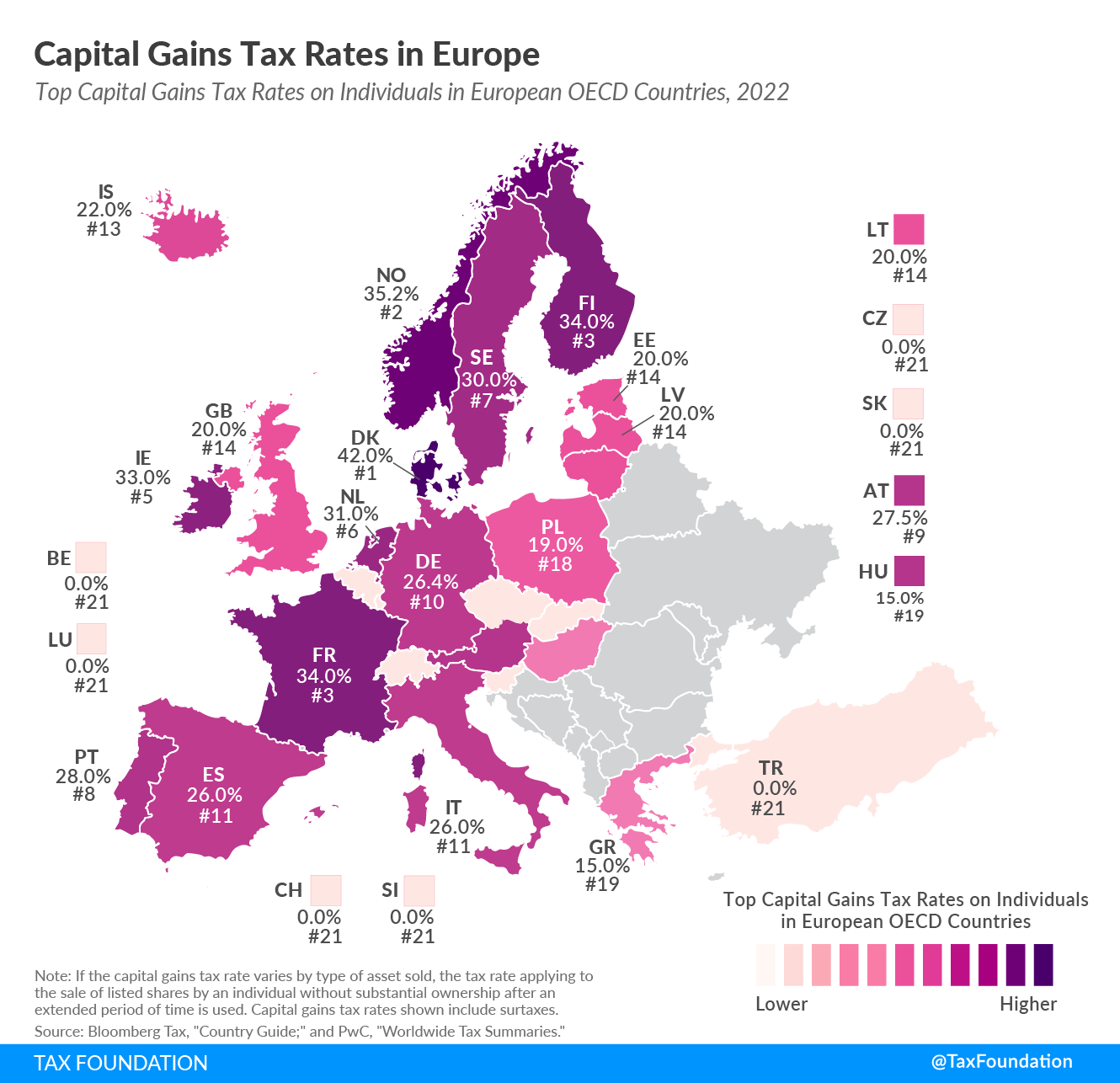As a 501(c)(3) nonprofit, we depend on the generosity of individuals like you. Help us continue our work by making a tax-deductible gift today.
The Tax Foundation is the nation’s leading independent tax policy nonprofit. Since 1937, our principled research, insightful analysis, and engaged experts have informed smarter tax policy at the federal, state, and global levels. For over 80 years, our goal has remained the same: to improve lives through tax policies that lead to greater economic growth and opportunity.
March 8, 2022
Cristina Enache
In many countries, investment income, such as dividends and capital gains, is taxed at a different rate than wage income. Today’s map focuses on how capital gains are taxed, showing how capital gains tax rates differ across European OECD countries.
When a person realizes a capital gain—that is, sells an asset for a profit—they face a tax on that gain. For example, if you buy a share for $100 and sell it for $120, you pay capital gains tax on your $20 gain.
The capital gains tax rates shown in the map are the top marginal capital gains tax rates levied on individuals, taking into account exemptions and surtaxes. If the capital gains tax rate varies in a country by type of asset sold, the tax rate applying to the sale of listed shares after an extended period of time is used.
Denmark levies the highest top capital gains tax of all countries covered, at a rate of 42 percent. Norway levies the second-highest top capital gains tax at 35.2 percent. Finland and France follow, at 34 percent each.
A number of European countries do not levy capital gains taxes on the sale of long-held shares. These include Belgium, the Czech Republic, Luxembourg, Slovakia, Slovenia, Switzerland, and Turkey. Of the countries that do levy a capital gains tax, Greece and Hungary have the lowest rates, at 15 percent.
On average, the European countries covered tax capital gains arising from the sale of listed shares at 19.4 percent.
Note: “PIT” refers to personal income tax.
Sources: Bloomberg Tax, “Country Guide,” https://www.bloomberglaw.com/product/tax/toc_view_menu/3380/; and PwC, “Worldwide Tax Summaries Online,” https://taxsummaries.pwc.com/.
Subscribe to get insights from our trusted experts delivered straight to your inbox.
Share
Tweet
Share
Email
Explore our weekly European tax maps to see how countries rank on tax rates, structure, and more.
Compare Your Country
Stay up on the tax news and analysis that matters to you.
Get facts about taxes in your country and around the world.
A surtax is an additional tax levied on top of an already existing business or individual tax and can have a flat or progressive rate structure. Surtaxes are typically enacted to fund a specific program or initiative, whereas revenue from broader-based taxes, like the individual income tax, typically cover a multitude of programs and services.
A capital gains tax is levied on the profit made from selling an asset and is often in addition to corporate income taxes, frequently resulting in double taxation. Capital gains taxes create a bias against saving, leading to a lower level of national income by encouraging present consumption over investment.
The Tax Foundation is the nation’s leading independent tax policy nonprofit. Since 1937, our principled research, insightful analysis, and engaged experts have informed smarter tax policy at the federal, state, and global levels. For over 80 years, our goal has remained the same: to improve lives through tax policies that lead to greater economic growth and opportunity.
1325 G St NW
Suite 950
Washington, DC 20005